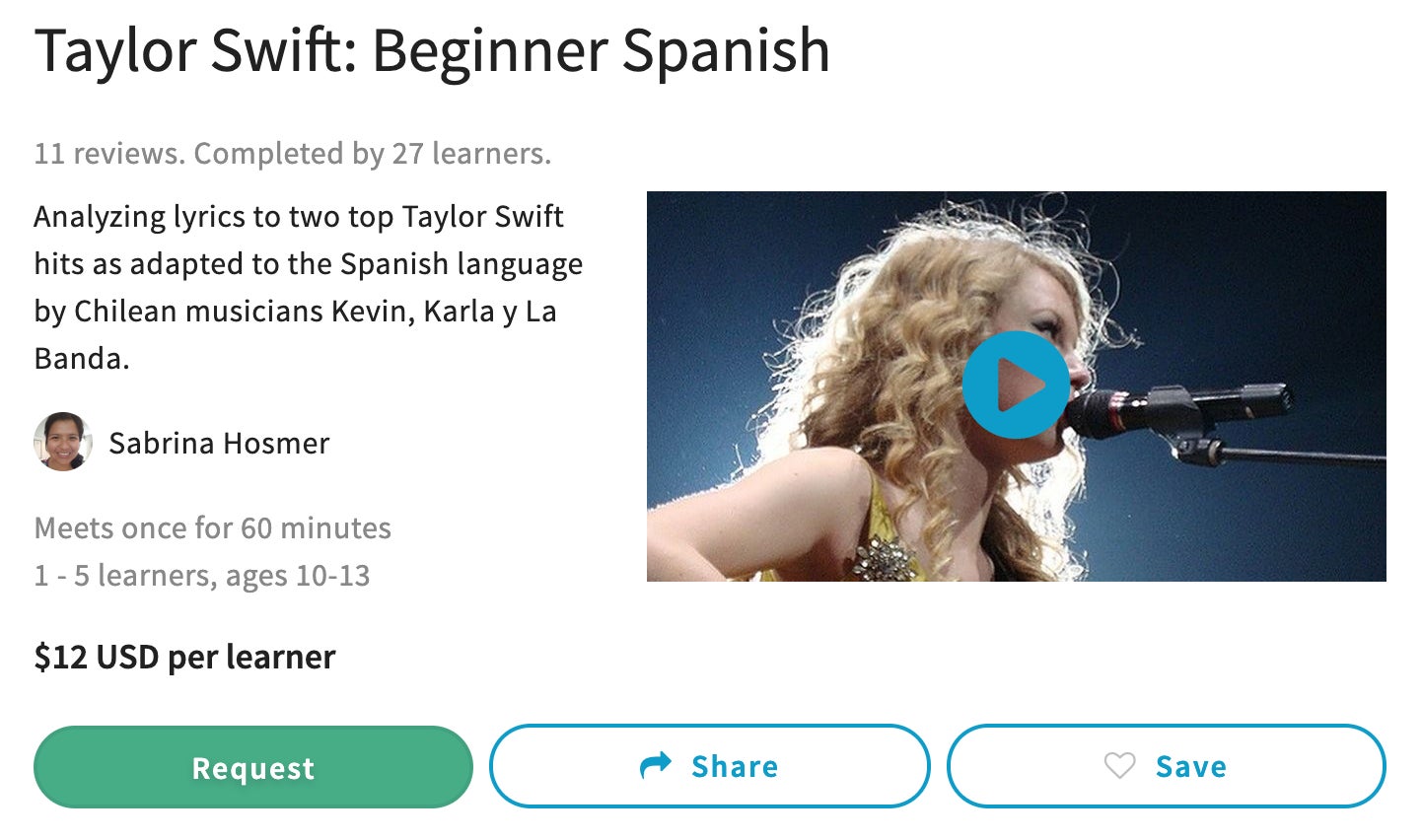Investors are betting the Netflix of education can give kids what schools can’t
Before Martin Luther King Jr. Day last year, Celeste Law’s eight-year-old daughter told her mother that she didn’t know much about Martin Luther King Jr. Law recalled seeing an ad for Outschool, a marketplace for small, online classes aimed at middle- and high-school students. She checked it out. There was a 90-minute class on King. She investigated the site, saw it was safe and cheap, and let her daughter try it.


Before Martin Luther King Jr. Day last year, Celeste Law’s eight-year-old daughter told her mother that she didn’t know much about Martin Luther King Jr. Law recalled seeing an ad for Outschool, a marketplace for small, online classes aimed at middle- and high-school students. She checked it out. There was a 90-minute class on King. She investigated the site, saw it was safe and cheap, and let her daughter try it.
Forty classes later, Law and her daughter are evangelists for Outschool. Her daughter has taken classes on Shakespearian insults, fashion design through the ages, Harry Potter-themed chemistry, fractions, and the sociology of Disney villains. Law recently overheard her daughter in the villains class discussing whether Gaston, the bully in Beauty and the Beast, was perhaps abused as a child.
“They are finding a niche that will grow: children wanting to become better learners, who learn for the right reasons rather than to cram for a test,” says Law. “It meets the child where their interests are.”
Investors are betting this niche will grow: San Francisco-based Outschool just raised $8.5 million in Series A funding from Reach Capital and Union Square Ventures, the latter of which backed Etsy and Twitter, among others. This is a big step up from a $1.4 million fundraising round two years ago, led by to Collab+Sesame, the venture capital partnership between the Sesame Workshop (the nonprofit behind Sesame Street) and the Collaborative Fund (a venture capital fund focused in part on social impact), in addition to Y Combinator, SV Angel, and Learn Capital, among others. The company declined to disclose a valuation in its latest round.
Outschool’s model is remarkably simple: it connects kids who want to learn stuff with people who want to teach it, in small online groups via video chat. Classes can be one-off or a semester long, and range from the quirky, like learning Spanish by singing Taylor Swift songs, to the practical, like mastering the five-paragraph essay. Outschool currently offers 8,000 classes from 1,000 teachers; 31,000 parents have bought classes, with 60% coming back for more. Around 80% of students are home-schooled. With the new funding, the company hopes to go mainstream.
In an era where there is seemingly nothing parents won’t do to help their children succeed, it’s an idea for the times. Says Law: “We are the kind of overbearing, suburban Chicago parents that want the best for our child, and we found a good way to supplement what she’s not getting in her private school.”
Supply and demand
Plenty of companies offer online learning, like Khan Academy or thousands of MOOCs (Massive Open Online Courses). And there are plenty of options for well-off families to hire tutors focused on high-stakes tests, college prep, and just about everything else. Outschool is doing something different: an online marketplace offering kids (and parents) extra opportunities for learning, either to help fill in holes or just pass the time with fun, and educational, stuff.

“We can help them pursue their interests, even as their interests change over time,” says co-founder and CEO Amir Nathoo. It’s an alternative to expensive private schools, tutors, and camps, thereby addressing a much larger market. At same time, it offers teachers a way to supplement their income, while broadening the pool of what constitutes a teacher: you have to be approved by the company to teach, but you do not have to be a certified teacher.
Parents increasingly want more than schools can reasonably offer, thanks to a focus on tests and deep budget cuts. Teachers could use extra income to supplement meager salaries, and also an outlet to channel passions that standardized testing have tried to kill.
“Too much of K-12 is focused on the end result and we are losing sight of the base purpose,” Nathoo says. “That’s to develop a love of learning.” (Also, parents might add: fill downtime with something other than dumb YouTube videos, teach kids cool stuff, and get them not to hate school.)
A marketplace for passions
Megan Hardy was a stay-at-home mom and found Outschool when she was looking for a way to get her son interested in history. She found the five-dollar course “Big Picture History: American History in One Lesson.” Her son loved it. He took a few more classes.
When her husband lost his job a year later, Hardy thought about creating a class to teach critical thinking and problem solving through Dungeons and Dragons (which she and her kids play all the time). She applied to Outschool and was interviewed, provided a lesson summary overview, and got approved within three weeks. After clearing a background check and going through on-boarding to learn the Zoom videoconferencing technology, she started teaching, in spite of never having taught before.
Hardy now teaches 40 to 50 hours a week. “It turns out, a lot of kids want to learn this,” she says, laughing at the sound of it. (Class description: “A Dungeons and Dragons campaign to teach critical thinking and to save the land from evil.”) She has students from all over the world, and makes $5,000-$7,000 a month—Outschool takes 30% of teachers’ earnings for marketing, admin, and handling all the billing.
Hardy’s classes run for six weeks and are 80 to 90 minutes each. She’s capped each class at six kids, so she can better manage the group. Her biggest challenge? Saying no: for a while, she was teaching classes at 2am.
The average class at Outschool is three to eight kids; 18 is the maximum. Prices average out to about $10-15 a class. Nathoo estimates that about 80% of kids use it for fun and 20% for core learning.
Benjamin Corey, who taught middle- and high-school biology for eight years in Atlanta and San Francisco, says he loves the freedom he has to build interesting classes. He teaches five to six hours a day, and offers 40 classes. Eleven are core classes, each four sessions long, which make up the equivalent of freshman biology. He also teaches 29 one-off classes, including a series on endangered species that address environmental topics via specific animals (orangutans and deforestation; orcas and biomagnification of pollutants).
He misses the interaction of a classroom—shared physical space and body language are key to teaching, he says—but has worked on making the online experience as rich as possible. He caps his classes at nine students and does a lot of diagraming, calls on everyone a lot, and never has a segment go more than 10 minutes. “I don’t see myself going back to the classroom any time soon, because it would be a pay cut and a lot more stress,” he says.
Human connection
Nathoo founded Outschool in 2016, with the idea that social connection was key to learning. “So much of ed-tech today is automated, putting tools or AI in the classroom,” he says. “We want to scale up the human connection, because what’s important for the kids is the interaction.”
It was the social aspect of Outschool that drew Jennifer Carolan, a former public school teacher and founder of Reach Capital, to invest in it. The big failing of MOOCs, where completion rates hover between 5-15%, is to ignore that humans are, at heart, social learners. “We learn from each other and teachers can be very impactful,” she says. Outschool matches curious learners to teachers who teach. “There’s a teacher who is passionate about the subject matter, and a small group of learners, and the tech that can enable social interactions between kids,” she says.
The biggest challenge was how to get started: parents won’t sign up without classes and teachers won’t teach classes without students. The company’s first iteration was in-person learning: Nathoo organized field trips in San Francisco for kids to go to museums with teachers and some learning goals in mind. Parents joined their kids and saw how they got more out of a visit when a teacher was there.
Carolan loved the idea, but didn’t think it could scale. When Nathoo pivoted to online, with small, live classes, she jumped in. As due diligence, she signed her daughter up for a class, watched, and was impressed. She vetted the team who vets the teachers, and ultimately invested two weeks later.
The challenge now is to attract teachers and students beyond the home-schooling community, aiming for kids who log on after school, in the summer, and during holidays. It might not be easy to gain traction beyond this community, namely for those parents uncomfortable with their kids taking classes from non-certified teachers.
Equal access
An unintended consequence (or perhaps not) of Outschool may be to reverse the seemingly intractable tide of inequality in education. Rich parents not only immerse their kids in expensive extracurricular activities but they also tutor their kids for just about anything, from help with math to honing their jumpshot. According to Carolan, the top 10% of families have ramped up their spending on outside education by 150% in the last 40 years.
“What we loved about the Outschool model is that it made it more accessible,” she says. The market for parents signing up for classes at $5 each, compared with tutors at $50 an hour (or far more at the high end), could be a big one, Outschool’s investors hope.
Another bonus: kids get to meet other kids from all over the world. Law says her daughter has friends from all over now; Carolan watched her daughter start a conversation with kids from two different countries about ponds. Hardy says kids in her Dungeons and Dragons class hail from Japan, Canada, Australia, the UK, and the US.
“We are more of a global community now and I think parents will want kids to have that opportunity,” she adds. “It will be part of getting your kids ahead.” That, and being able to sing Taylor Swift songs in Spanish.